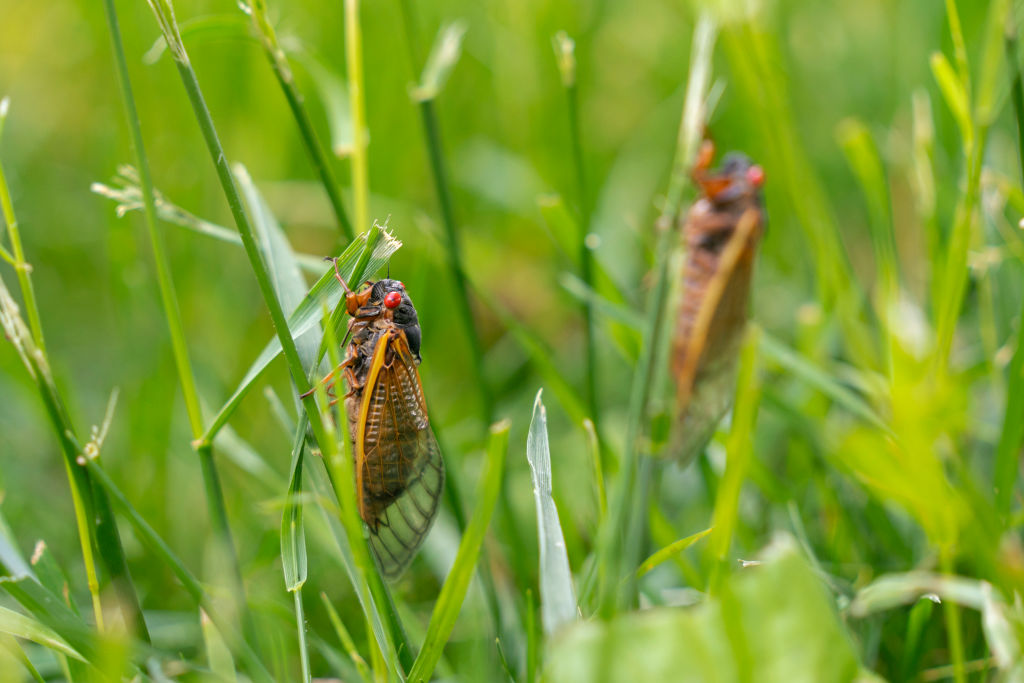With reports of spinning fish, lengthening heatwaves, and the rest, we might reasonably flinch at the phrase “ecological event.” But here’s one such event many of you can enjoy, even embrace, right here in the U.S., from your back deck or on a walk in the woods: a massive emergence of cicadas.
They’re a special kind of cicada that live underground for 13 to 17 years, and live in separate geographic groups, or broods, that follow a similar cadence of emerging from the earth, mating, and reproducing. What makes this year’s proliferation remarkable is that two neighboring broods are emerging at the same time, in one of the largest co-emergences on earth.
“Kids will remember this for their lifetime,” Catherine Dana, an entomologist and an affiliate at the University of Illinois Urbana-Champaign’s Illinois Natural History Survey, told Scientific American. “Maybe they will remember it as being disgusting and loud, but it’s also, in a way, magical.”
The nymphs of the Great Southern Brood of cicadas, also known as Brood XIX, began to emerge in late April, after 13 years spent underground. The Northern Illinois Brood, aka Brood XIII, should begin emerging this month, after 17 dark years. Between the two broods, regions that include 17 states will experience this ecological event, from Wisconsin south to Louisiana, and from Oklahoma east to Virginia. In places where these cicadas emerge, their numbers will be unmissable: A good estimate for ideal cicada habitat, if not necessarily your lawn, is about a million cicadas per acre.
It’s one of the larger co-emergences of cicadas in nature. These broods are also geographically next to each other—another rarity. Co-emergences don’t happen very often. And certain co-emergence combinations are very rare indeed. These two broods last emerged together in Thomas Jefferson’s first presidential term, in 1803.
The Louisiana Purchase was made in April of that year, just about the time cicada nymphs in some of that territory may have emerged, so they were born French and died Americans. By that October, when Lewis and Clark formed the Corps of Discovery, those new cicada-citizens had mated and died, and their young were safely growing underground, waiting to emerge years later as adults.
Not your everyday cicadas.
These cicadas are not the same species of cicadas many of us hear every year in summer. Those are annual cicadas, a completely different set of species that emerges from late spring to late summer. This year’s mass emergence are all periodical cicadas, in the genus magicicada, so called because they emerge every 13 or 17 years, in spring, as soon as the topmost 6 inches of soil reaches 64 degrees Fahrenheit.
They’re fairly easy to distinguish. Periodical cicadas have black bodies, vivid red eyes, and orange wing veins. Annuals don’t have red eyes and usually have some green on their bodies.
Their life cycles are similar. Nymphs emerge from the ground after sunset and immediately ascend the nearest tree or shrub. They climb out of their nymph clothing (molt), hang out for a few days while their new exoskeletons and wings harden, and the males begin their choruses, attracting answering females. After mating, the females go off to lay their eggs in thin twigs, and after a few weeks the new nymphs—orphans by this time—hatch, drop to the ground, and burrow until they find a root to feed on, until it’s their turn to emerge.
Of the 3,000 to 5,000 species of cicadas worldwide, fewer than 10 are periodical. And seven of those are in the North American magicicada genus, found in most of the deciduous forests of the eastern half of the U.S. They’re an insectile form of American exceptionalism.
Staying true to their brood.
By itself, there’s nothing exceptional about a brood emergence. It happens in almost any given year. Nor does “brood” have any biological significance. It’s something we’ve imposed on periodical cicadas to keep track of their emergences. They are “regional, multispecies groupings of periodical cicadas that emerge on a common schedule,” according to researchers at the University of Connecticut.
Like jigsaw puzzle pieces, cicada broods generally don’t overlap geographically, and are usually but not always contiguous (some broods have isolated areas separate from their main territory, kind of like Kaliningrad). In the few places where two broods overlap, the songs of identical species in each brood are different enough to keep them from mating with a member of the wrong brood.
Brood XIX, the Great Southern Brood, is one of the largest, covering 15 states from Illinois to Louisiana, from Oklahoma to Virginia. Of the 15 total periodical cicada broods, three are 13-year cicadas (found mainly in the South and Midwest) and 12 are 17-year cicadas (found mainly in the Northeast and northern Midwest).
Cicada broods seem to have been formed by long-term climate variations. According to genetic research, Magicicada neotredecim—a periodical species in the northern Mississippi Valley—formed during an interglacial (i.e., warming) period about 200,000 years ago, evolving from a 17-year cicada to a 13-year one.
Cicadas aren’t perfect timekeepers, and some brood members will emerge earlier or later than the rest of the brood, varying by one or four years. The number of these stragglers can be low to upward of thousands.
It’s a numbers game.
For the vast majority of more punctual cicadas, their mass emergence is most probably a defensive-offensive survival strategy. Emergences aren’t a steady release of cicadas, or a single burst of bugs, but a series of quick pulses. Emerging in such massive numbers—more than predators could possibly eat—guarantees that enough mating pairs will survive to pass along their genes to the next generation of cicadas.
“Their defense is coming out in the billions,” Martha Weiss, an insect ecologist at Georgetown University, told Scientific American. “Predators really just can’t possibly eat all of them.”
Because of the long periods between emergences, predator populations can’t build up (at least by feeding on the cicadas). Mass emergences also help other prey of these predators, by taking some of that predation pressure off them.
Those predators are many, from spiders and wasps (including one cicada specialist) to trout and bass, snakes, birds, and mammals. Domestic dogs will scarf them down.
Cicadas do their share of eating, too, both as earthbound nymphs and adults, which they do by harmlessly sucking the watery xylem from the roots or branches of trees or shrubs.
If a cicada happens to land on you, remain calm. As the UConn team points out, although their eyesight is keen, after millions of years on the earth, cicadas may make the reasonable assumption that any vertical object is a host plant.
After so many years underground, what summons periodical cicadas to emerge? Researchers don’t really know. Science writer Carl Zimmer observes that mass emergence can’t depend on temperature alone. If it did, the natural variation in soil temperature would mean that cicadas in the same patch of woods would emerge at different times, making them easier pickings for predators.
To pull off a synchronous pulse, there must be some additional cue. One theory, still unproven, is that nymphs somehow communicate with each other.
However this year’s cicadas wake up, no real harm will come from this emergence, or any other. You may want to outfit any young trees or shrubs you want to protect with cheesecloth or some other bird-proof covering. Mature trees and shrubs quickly recover from any superficial damage they may suffer.
A full-on cicada emergence can get loud–about 90 decibels at the loudest. That’s comparable to the noise from a lawnmower or a hair dryer. But there is no awe in the sound of the Toro next door, while there is plenty in the equally loud rush of Niagara Falls or the roar of a lion.
The jury is out on whether your pets should eat cicadas. As for us, although it’s easy to find recipes online featuring cicadas (the taste resembles a shrimp bouquet with nutty overtones, it’s said), you might just say no. The UConn team notes that cicadas are known mercury bioaccumulators—that is, over their lives they accumulate environmental mercury.
But an imitation cicada at the end of a fly line apparently will do well on any game fish, including trout. Serve sans cicada.








Please note that we at The Dispatch hold ourselves, our work, and our commenters to a higher standard than other places on the internet. We welcome comments that foster genuine debate or discussion—including comments critical of us or our work—but responses that include ad hominem attacks on fellow Dispatch members or are intended to stoke fear and anger may be moderated.